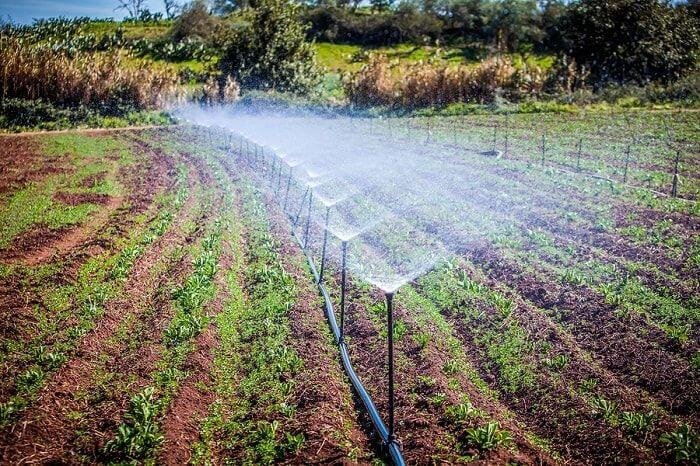Choosing a risk system is not easy. There are many options, very different prices and important questions to consider depending on your garden. Tips.
Having an adequate irrigation system is important when planning the maintenance of your garden or starting the garden you always dreamed of. Not only is it a fundamental requirement to keep them healthy but it is a good way to reduce the time it takes to care for them. We share a guide with the most popular types of irrigation , their advantages and disadvantages and how to install them in your home.
Types of irrigation systems
Table of Contents
Irrigation systems are designed to meet the needs of your crops and reduce your physical effort and the time it takes. They are important to cover the lack of rain or to regulate the amount of water that the plants or the lawn itself receive. Find out the best options to take care of your garden or your garden in a practical and efficient way.
Before choosing the correct system for your patio, you should make a preliminary evaluation to determine the climatic conditions of the place where you live, the space to irrigate, the available water and the amount you need to supply. With these data, you can choose the most appropriate irrigation according to your needs and possibilities. The options are:
Drip irrigation
If you have horticultural plants or flowers in your garden , the drip system is undoubtedly the ideal system. It has a high level of efficiency because it applies small amounts of water locally to the roots of the plants.
The system consists of a flexible pipe where as many drippers as necessary are inserted. The amount of them will depend on the size of the patio and the number of plants you need to water.
What is the function of the droppers? Dose the water correctly so that the necessary liquid is supplied and waste and excesses are avoided.
There are three types of droppers :
- Self-compensating drippers: they are characterized by having a homogeneous irrigation . With these dispensers you will be able to give the same amount of water to each plant regardless of the pressure in the place of the irrigation line where they are located.
- Anti-drain drippers: they close automatically when the water pressure drops, preventing air from entering the irrigation system. This feature makes it a safe and efficient dripper.
- Adjustable drippers with which you can manually manage the amount of water, increasing or decreasing the liquid according to your tastes and needs.
The advantages of drip irrigation are many:
- It improves plant growth because it is applied to the roots. And, by not watering the leaves and stems, you prevent your plants from getting fungus.
- It keeps the soil permanently moist, something key for some types of plants such as horticulturals.
- It favors the saving of water.
- It is adaptable to any type of soil, either with slopes or rocks.
Although there are not many, this system also has some disadvantages :
- Depending on the quality of water you use, the droppers can become clogged or damaged. The solution will be to check them regularly.
- The cost of installation is high. However, the water savings you will achieve makes it still a convenient system.
- As it is a fixed system, you will have to take special care not to damage it when cutting the grass or performing tasks on the ground.
Sprinkler irrigation
It is a great option for gardens with a lot of grass and low plants. This system consists of sprinklers or bartoliths that are placed along the ground and, by means of a network of pipes and a pump that gives pressure to the water, allows a uniform irrigation of the entire surface.
Various forms of sprinkler irrigation can be found:
- Fixed – The sprinklers are placed in one place and irrigate the same area for a specified time.
- Mobile : sprinklers move from zone to zone manually.
- Pivoting : it has a system that makes them rotate so that they can cover a greater space.
Among the advantages of this system are the possibility of watering large spaces with little effort and regulating the water supply as needed. In addition, if you have an automatic sprinkler irrigation, you will only have to program it to obtain the amount of liquid you want and the days you want without having to monitor or move it.
When you need to water large areas, the plumbing system will allow you to sectorize the sprinklers and control them by zone. In this way, you can irrigate each sector with more or less water depending on rainfall, drought or humidity.
Some of the disadvantages of this type of irrigation are:
- By requiring installation of pipes and pipes, the initial cost of installa/tion will be high.
- It has a higher water consumption than other systems such as drip systems.
- It is less efficient in plants that need watering at their roots.
- It increases the possibility of fungi due to the humidity it produces on the leaves of some plants.
Mist irrigation
The “Fog System” or mist irrigation is a system in which water is supplied in the form of very small drops, similar to a fog or thick drizzle. This type of irrigation also helps to lower the temperature of the place where it is placed, which is why it is widely used in greenhouses and for growing mushrooms.
Depending on your needs, you will be able to choose between two styles:
- Low pressure : for home use, on terraces or in small greenhouses. They need little water pressure because the space to water is small.
- High pressure: for professional use. Its drops are finer and are used in large greenhouses. It is also common to see them in restaurants and hotels, which choose them to cool environments on very hot days.
The materials required to install a sprinkler irrigation system are similar to those for sprinkler irrigation. What should be particularly considered in this case is that the nozzles of the nebulizers can clog, so it is important that they have a filter.
If you want to install it in your home, it is best to purchase the entire low pressure irrigation kit and connect it to a normal water connection. In case you are looking for a more comfortable alternative, you can opt for an irrigation automation.
The biggest disadvantage of this system is that, by causing so much humidity, some fungi can begin to appear on the plants. In addition, it is not highly recommended for those who live in areas with a tropical or fairly humid climate.
Micro-sprinkler irrigation
If your plants need low volume irrigation, micro sprinklers are a great alternative for your garden. Like the previous one, this system is also widely used in nurseries and to moisten flowers and leafy vegetables.
Micro-sprinkler irrigation has rotating elements that serve to distribute very fine drops of water and moisten large areas evenly.
Although it seems that the system is similar to the fogging system, the main difference is that the micro-sprinklers expel the water through small jets and it is the rotors that are responsible for distributing it on the surface.
To mount this type of irrigation at home you will have to acquire the elements of the kit but you do not need tools or much effort. They can be installed on any pipe or on rods with microtubes.
The advantages are:
- It is versatile and adaptable to various types of floral, horticultural and fruit plants.
- Less water is used than with traditional sprinkler irrigation.
- Irrigation is uniform and the system is easy to use.
- Its use helps to lower the temperature and raise the humidity, causing a necessary microclimate for some types of plants.
As a disadvantage of this system we can name:
- Being fixed and with elements that protrude from the ground level, it runs a greater risk of breaking.
- If there are strong winds, the distributed water may stop being uniform.
- If you stop using it for a while, you are prone to clogging your mouthpieces.
Home irrigation system
If you are one of those people who love to create their own tools, we will tell you how to assemble a home drip irrigation system with elements that you can easily find or purchase. You will need:
- A large plastic bottle.
- A sewing knife or needle.
- Paper tape.
With these elements you can build three different irrigation systems.
- Burying a bottle with small holes.
You will have to cut the bottom of the bottle with the knife and make small holes in the body of the bottle (you can make them by heating the tip of the sewing needle). Then I put the bottle on the ground without the cap and loaded it with water.
- Piercing the cap and burying the bottle in the ground .
This is a great way to save water while watering very close to the roots. To achieve this, I followed the following steps:
- Punch small holes in the cap of the bottle.
- Screw the cap on tightly.
- Cut the bottom of the bottle with the knife.
- I put the bottle in the dirt with the cap down.
- Fill the bottle with water using a hose.
- Drip irrigation from the base of the bottle.
To assemble this system, you will have to pierce the base of the bottle with a hot sewing needle, ensuring that the holes are not too large. Then, try to fill the bottle with water and check that the drip is approximately every one second.
Finally, bury the bottle next to the plants you want to water with the cap up and start loading it again.
The options to take care of your garden are varied and can be adapted to different needs and budgets. Use this guide to choose the perfect irrigation to make your green spaces look beautiful and radiant.

